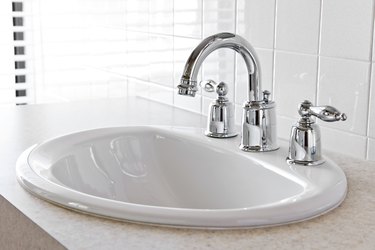
If you have chrome faucets, they will get cloudy. It's inevitable. The cloudiness comes from minerals in the water supply, and since that water flies around in the air when you shower and condenses onto every surface in the bathroom, no part of a faucet is safe from mineral deposits.
The mineral most responsible for cloudiness is calcium, but others, including manganese and magnesium, also contribute. These minerals don't just sit on the surface of the chrome; they actually bond with it chemically, which is why they are so difficult to remove. You might have had some luck removing some of the stains using dish soap and water and scrubbing with a microfiber cloth, but if the stains are deeply embedded, you won't be able to get them all out this way. You'll have better luck with Bar Keepers Friend, but even that might not be strong enough for really tough stains.
Video of the Day
Video of the Day
The trick is to use an acid strong enough to dissolve the bonds between the minerals and the metal, but you have to be careful with chrome because a strong acid will actually dissolve the chrome plating. Don't worry, though. You have acids that are plenty strong enough for the job — and that won't harm the chrome — in your kitchen cabinet and your refrigerator.
Tip
An easy and safe way to remove water stains from chrome is to use vinegar or lemon juice. You can also use a commercial stain remover or scrub with baking soda for really tough stains.
Remove Stains With Vinegar
Not just for seasoning French fries and salads, distilled white vinegar also happens to be a formidable household cleaning agent because it's a weak acetic acid solution. It will dissolve hard water deposits without harming the chrome, but it has to be in contact with the metal for a while to do the job. There are several ways to make this happen:
- Mix a 50-50 solution of vinegar and water in a bowl. Soak an absorbent cloth in the solution, wrap it around the faucet, and let it sit for about an hour. If it dries out, use a hand sprayer to wet it down with the vinegar solution.
- Remove all parts of the faucet that are removable and drop them into the solution. It's also a good idea to disassemble the faucet valves and soak them too because they are probably already partially blocked with mineral deposits. Don't forget to turn off the water supply valves before you do this. Wrap the remaining parts of the faucet with a vinegar-soaked cloth.
- Make a paste using borax and vinegar and spread it liberally on the faucet. Wet it down with a sprayer when it dries out. After about an hour, wash off the paste with clean water.
Remove Stains With Lemon Juice
Like vinegar, lemon juice is acidic (it's high in citric acid). Use it the same way you would use the vinegar solution but don't dilute it. It works best when you use it full strength.
You can also clean the faucet simply by rubbing it with half a lemon. This may be the best approach if the stains aren't extensive and have collected in just a few spots — for example, around the spout and handles. If the lemon juice needs time to work, crush the lemon on the affected part of the faucet and secure it there with a twist tie. When you remove the lemon, you should be able to scrub off anything that's left of the stain with dish soap and water.
If you need to scrub the faucet, use a microfiber cloth and not a kitchen scrubbie. A scrubbie is just abrasive enough to make small scratches on the chrome, and you won't be able to remove those.
Some Alternative Cleaning Methods
Some commercial products work faster than vinegar and lemon juice. One of the best known is CLR Calcium, Lime & Rust Remover. It contains not one but four different acids, and none are strong enough to hurt the chrome provided you use the product according to the directions. This stuff also gets rid of rust more quickly than either vinegar and lemon juice do.
If the stains aren't too advanced, you may be able to remove them with baking soda. Mix 4 tablespoons with a quart of warm water to make a thin paste and spread the paste liberally on the metal. Let it sit for 15 minutes or more and then wipe it off with water and a microfiber cloth. Use the cloth to scrub the faucet to a shiny finish. You may want to rub with a polish for extra shine.